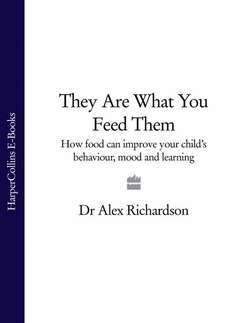Читать книгу They Are What You Feed Them: How Food Can Improve Your Child’s Behaviour, Mood and Learning - Dr Richardson Alex - Страница 73
Vitamin A (Retinol)
ОглавлениеVitamin A is critical for your immune system, vision, the brain and nervous system, the linings of your gut and lungs, and your bones and teeth. It’s also essential for reproduction and growth.
In the developing world, vitamin A deficiency accounts for more infant blindness (and thus mortality) than any other single nutrient deficiency. Insufficient vitamin A can stunt your child’s growth, weaken his immune system, damage the delicate linings of his guts and lungs, and impair his vision (particularly in dark conditions). It’s essential to numerous cell-signalling systems in your child’s body and brain.
Deficiency can reduce appetite and taste, and has been implicated in various autistic-type symptoms, including visual perceptual problems.6
Relatively few foods contain the active form of vitamin A (retinol). Organ meats (liver, kidneys, heart and brain) and oily fish are the richest dietary sources, but egg yolks and full-fat dairy products contain some. An artificial form (vitamin A palmitate) may be added to skimmed and semi-skimmed milk, but in anyone whose gut may be unhealthy (as we’ll discuss in the next chapter) this might not be absorbed properly. Vitamin A can also be made within the body from beta-carotene and other carotenoids. These substances help give carrots and other orange, yellow or green vegetables their natural colours. There’s no danger of accidental overdose with this route, as you only make what vitamin A you need from carotenoids. (As we’ve seen, active vitamin A can be toxic in excess—which is why warnings are issued to pregnant women to be careful about their intake—especially from supplements.)
According to the latest UK survey, your child is far more likely to get too little vitamin A than too much. In every age group, between one-half and two-thirds of all children were found to be getting less than the official daily ‘adequate intake’ of vitamin A from their diets. For those aged between 11 and 14 years, frank dietary deficiency was found in more than one in eight boys, and one in five girls.7 If you think your child’s intake may be too low, you could encourage him to eat more oily fish, liver, pâté or cod liver oil—but only in moderation, as these all provide active vitamin A. You can be more liberal with the carrots, oranges or other sources of beta-carotene from fruits and vegetables, as it’s hard to overdo it on these. The worst that’s likely to happen is that your child’s skin might temporarily turn a harmless shade of orange! (This did actually happen once to someone in my lab who adored tangerines, and ate them by the netful! She was a little alarmed, but came to no harm and learned her lesson: Vary what you eat.)
